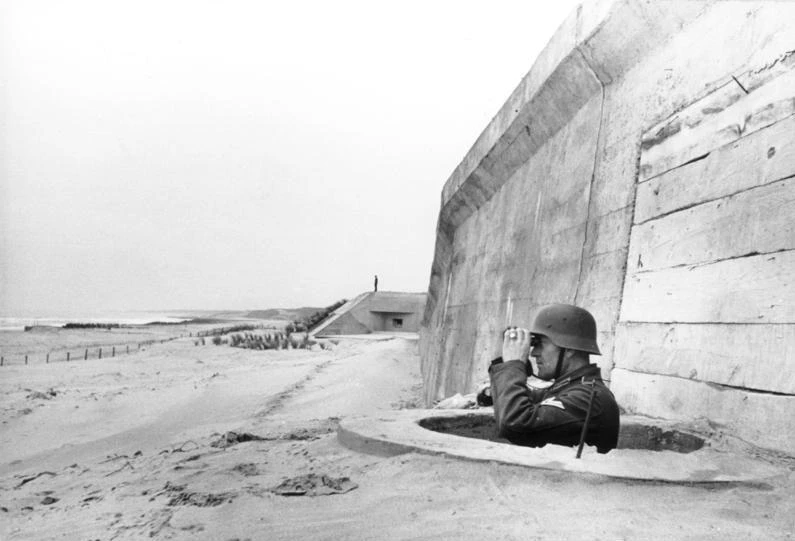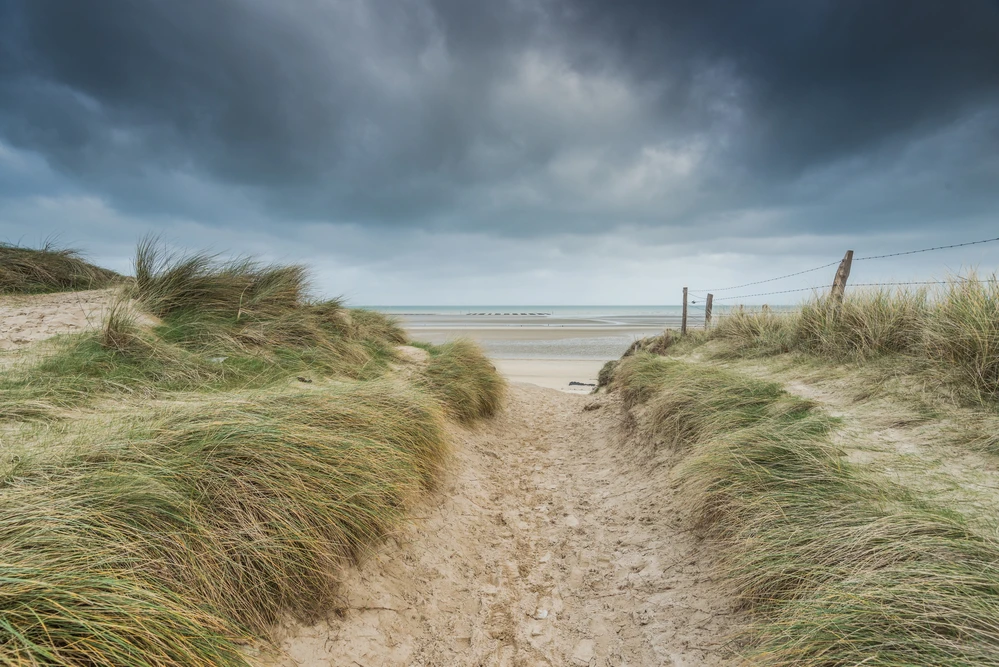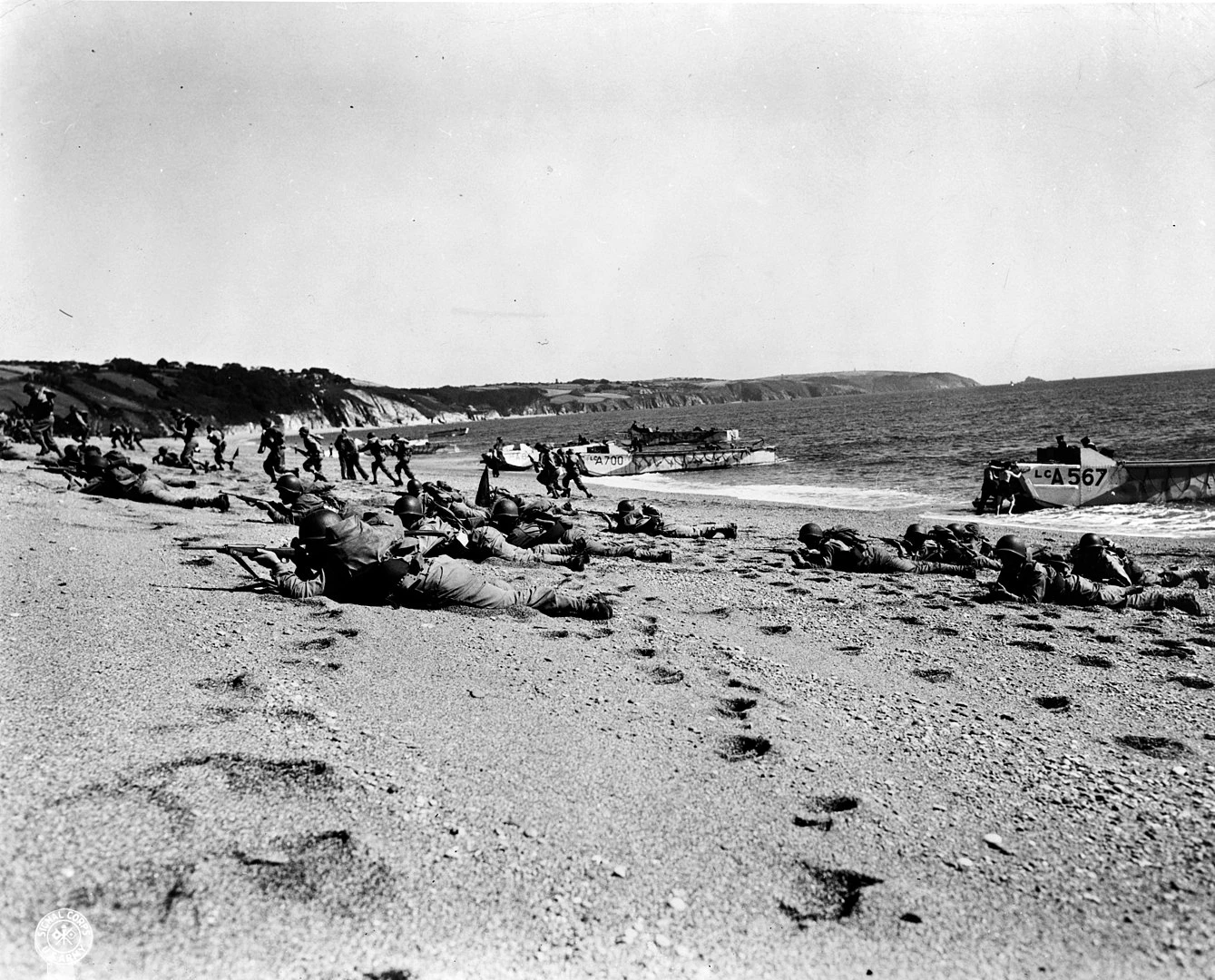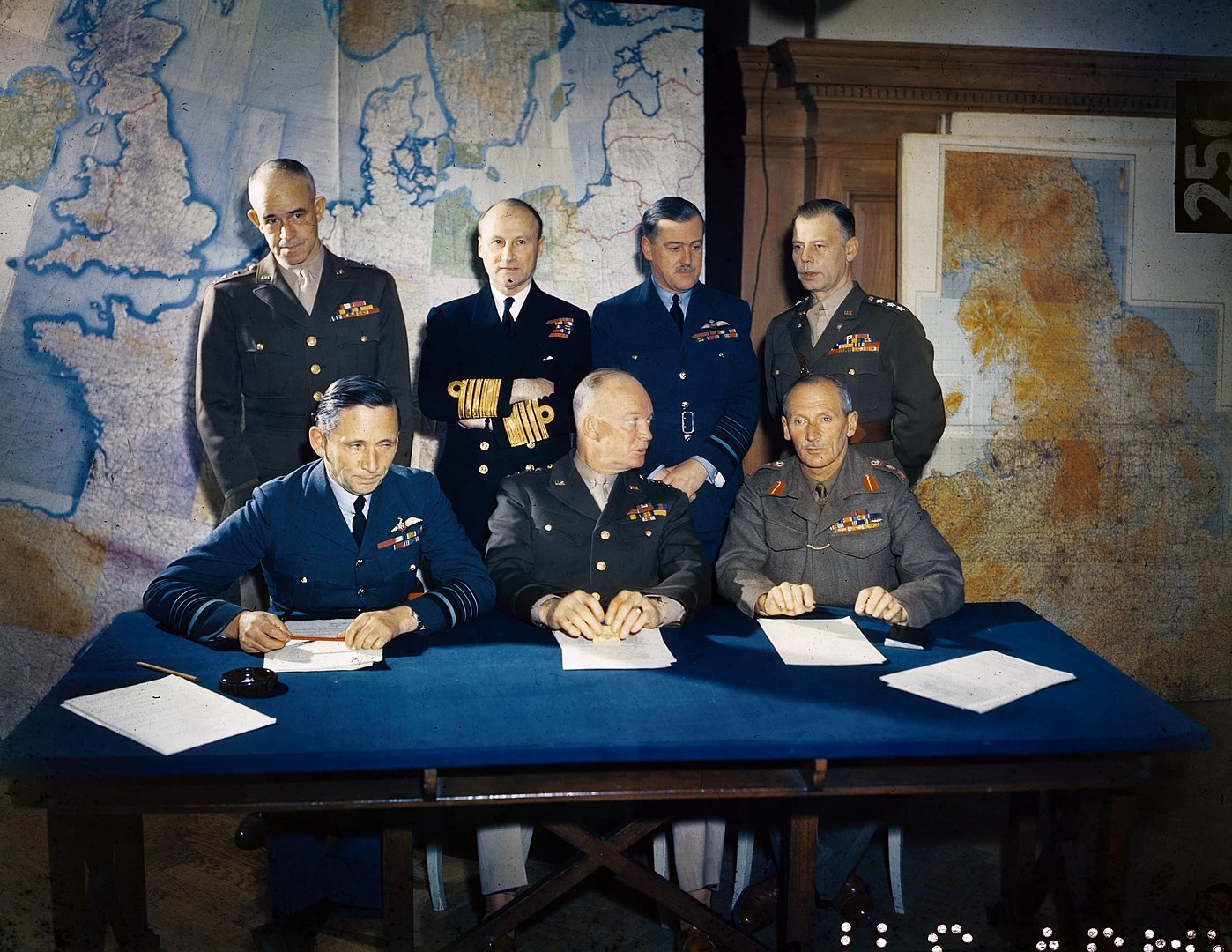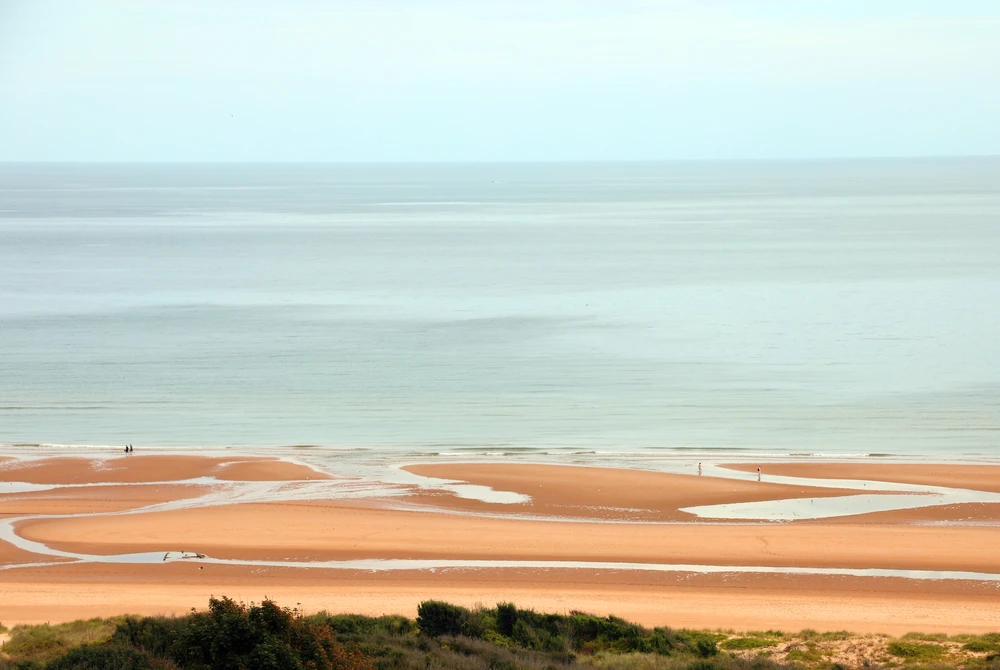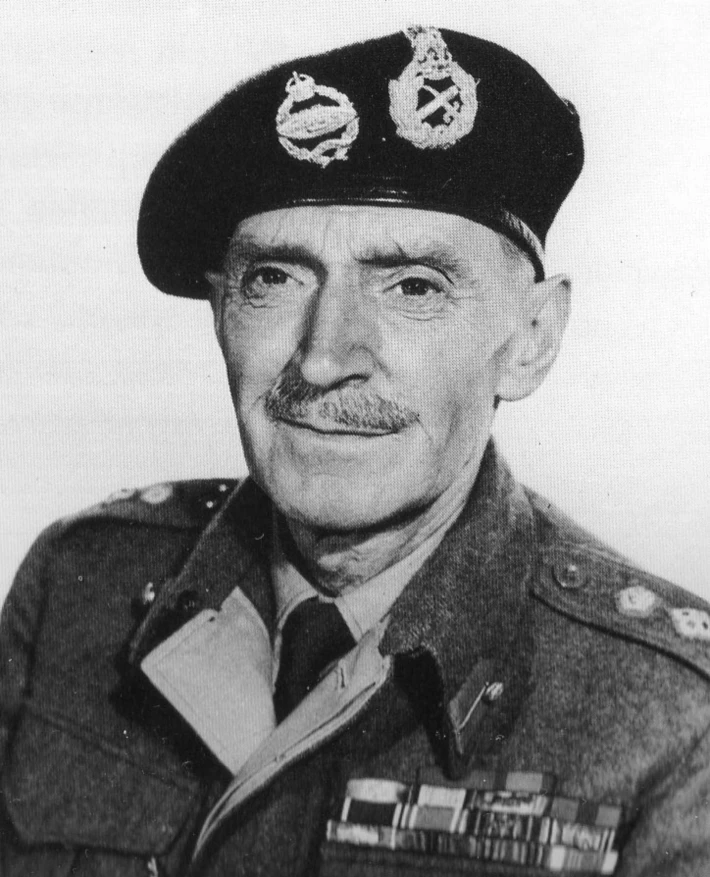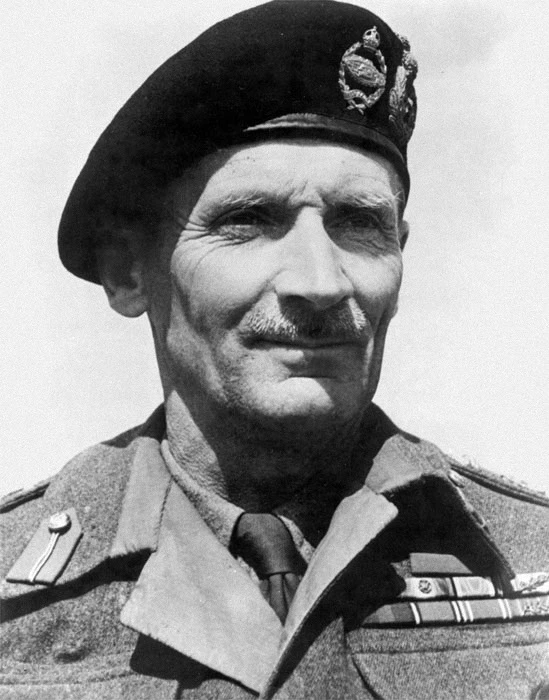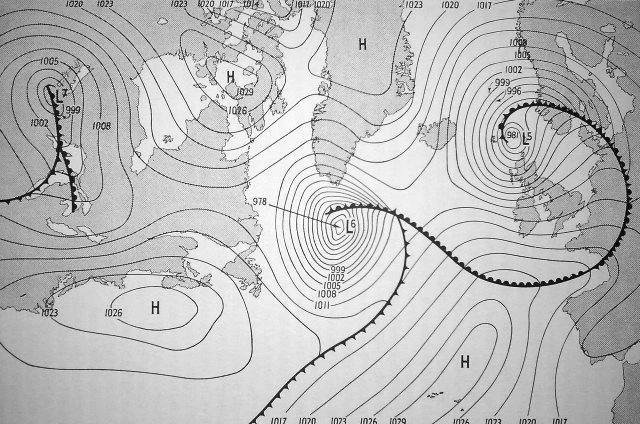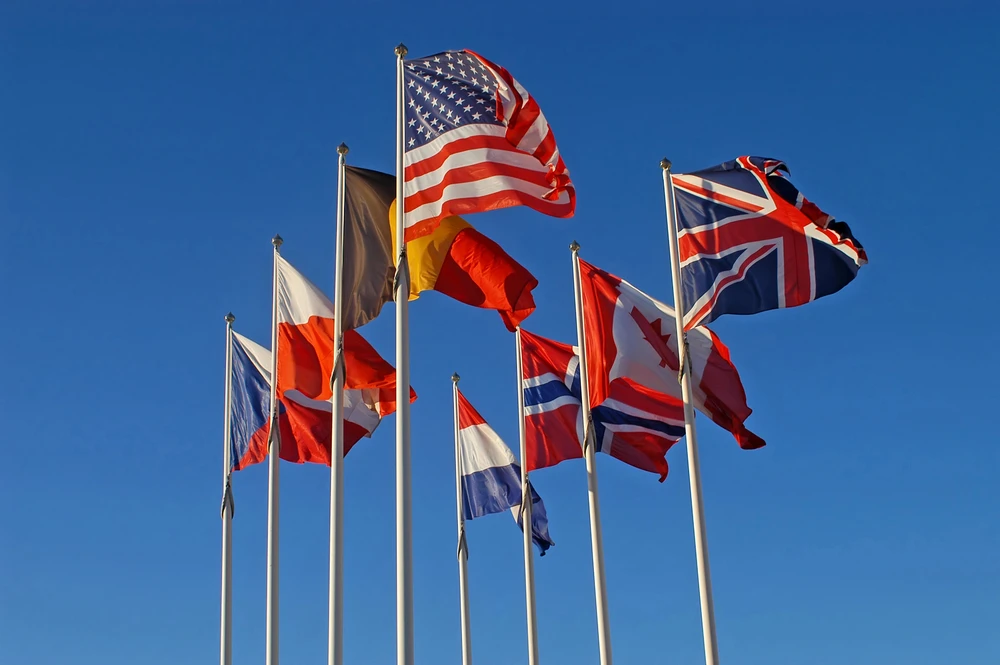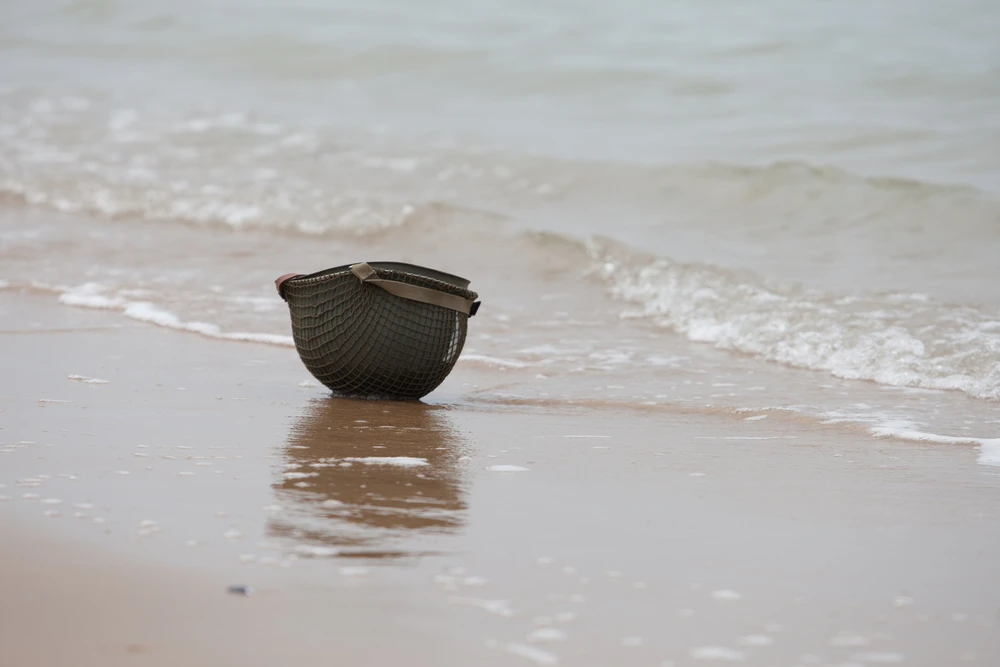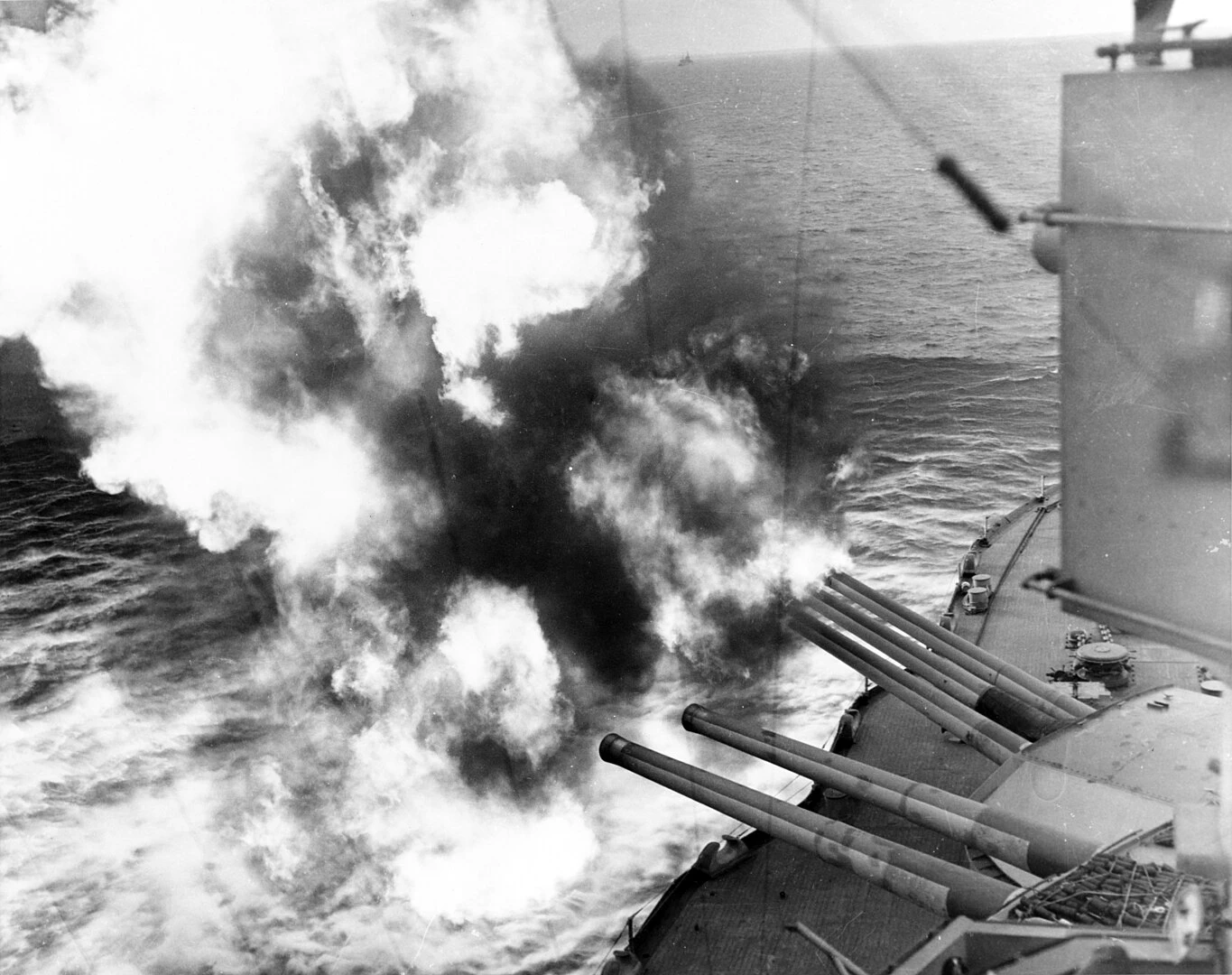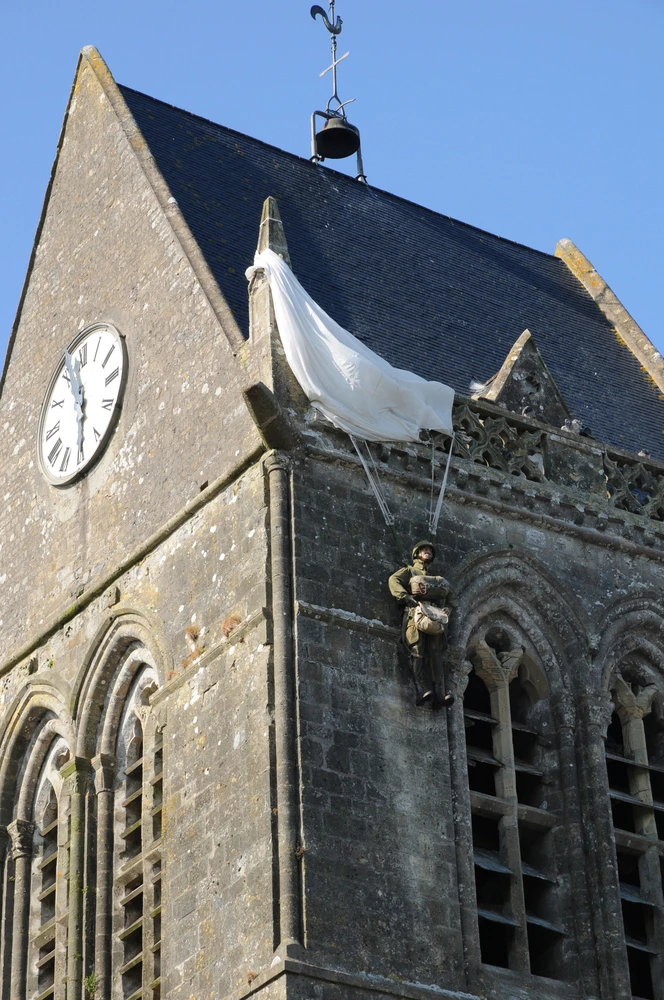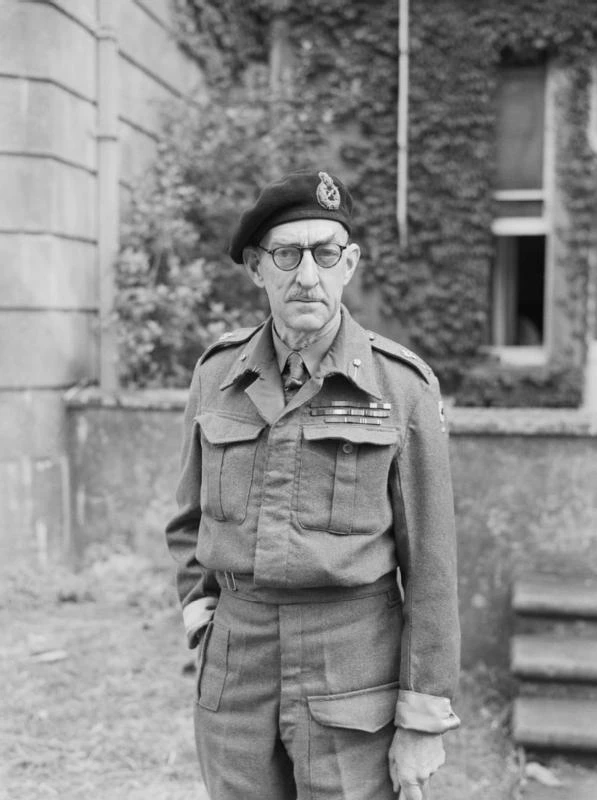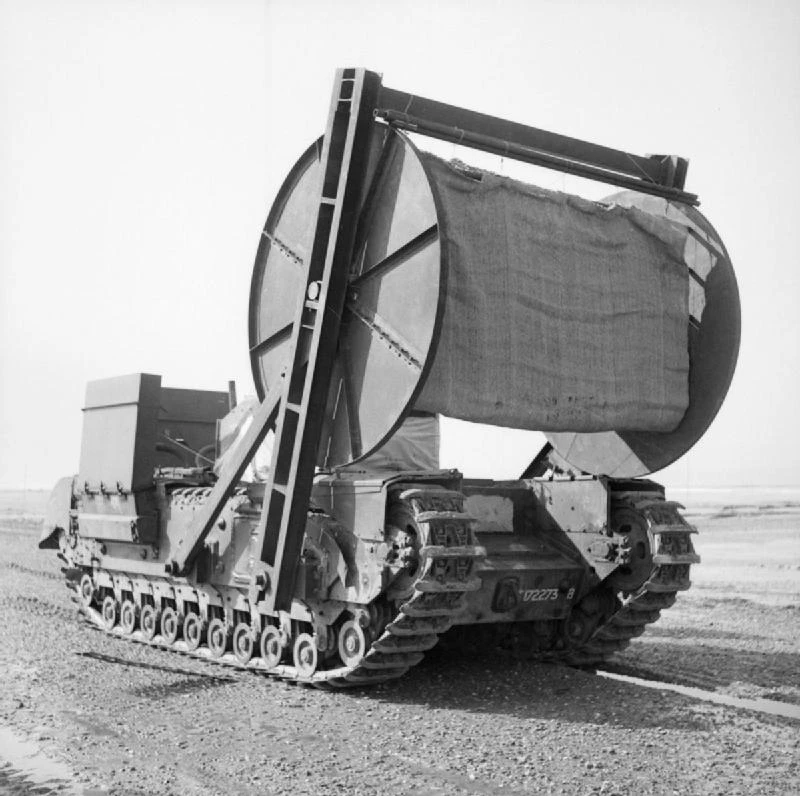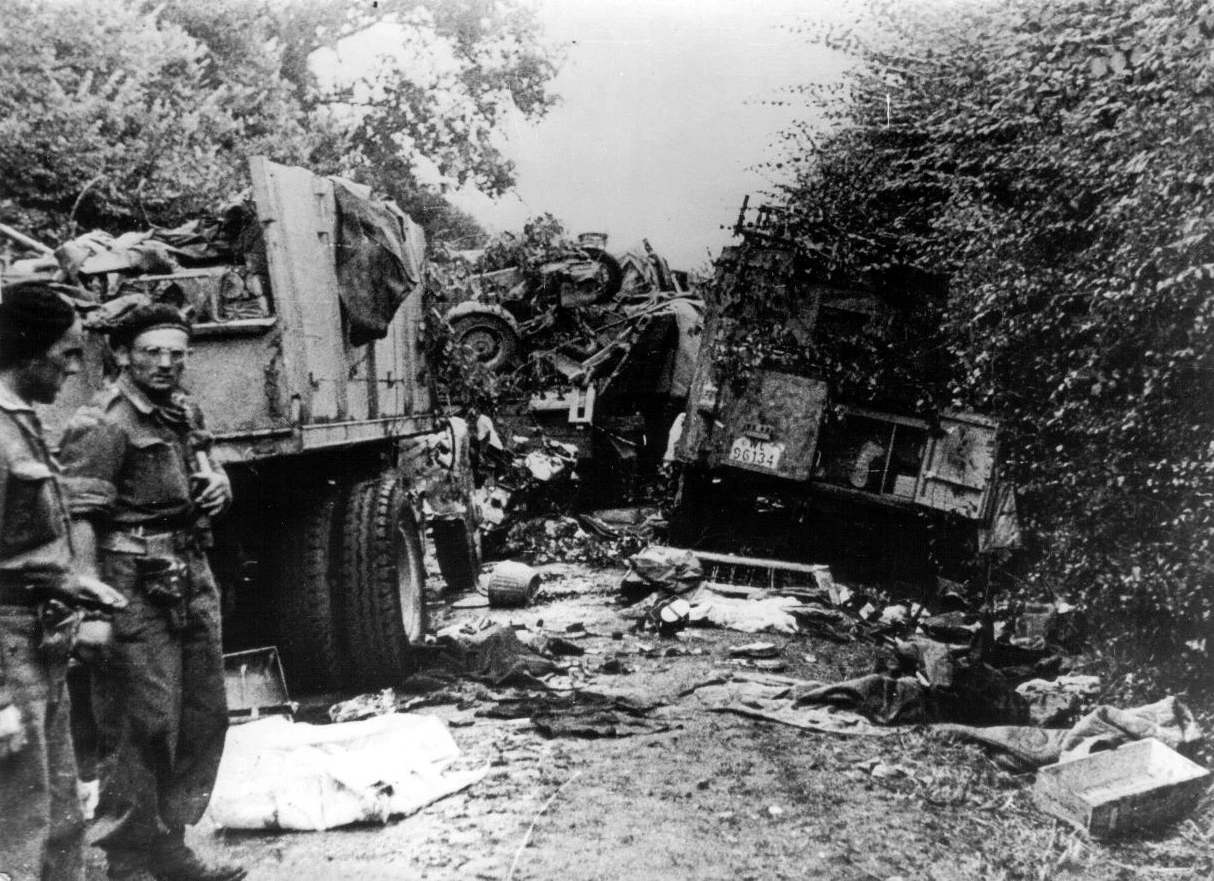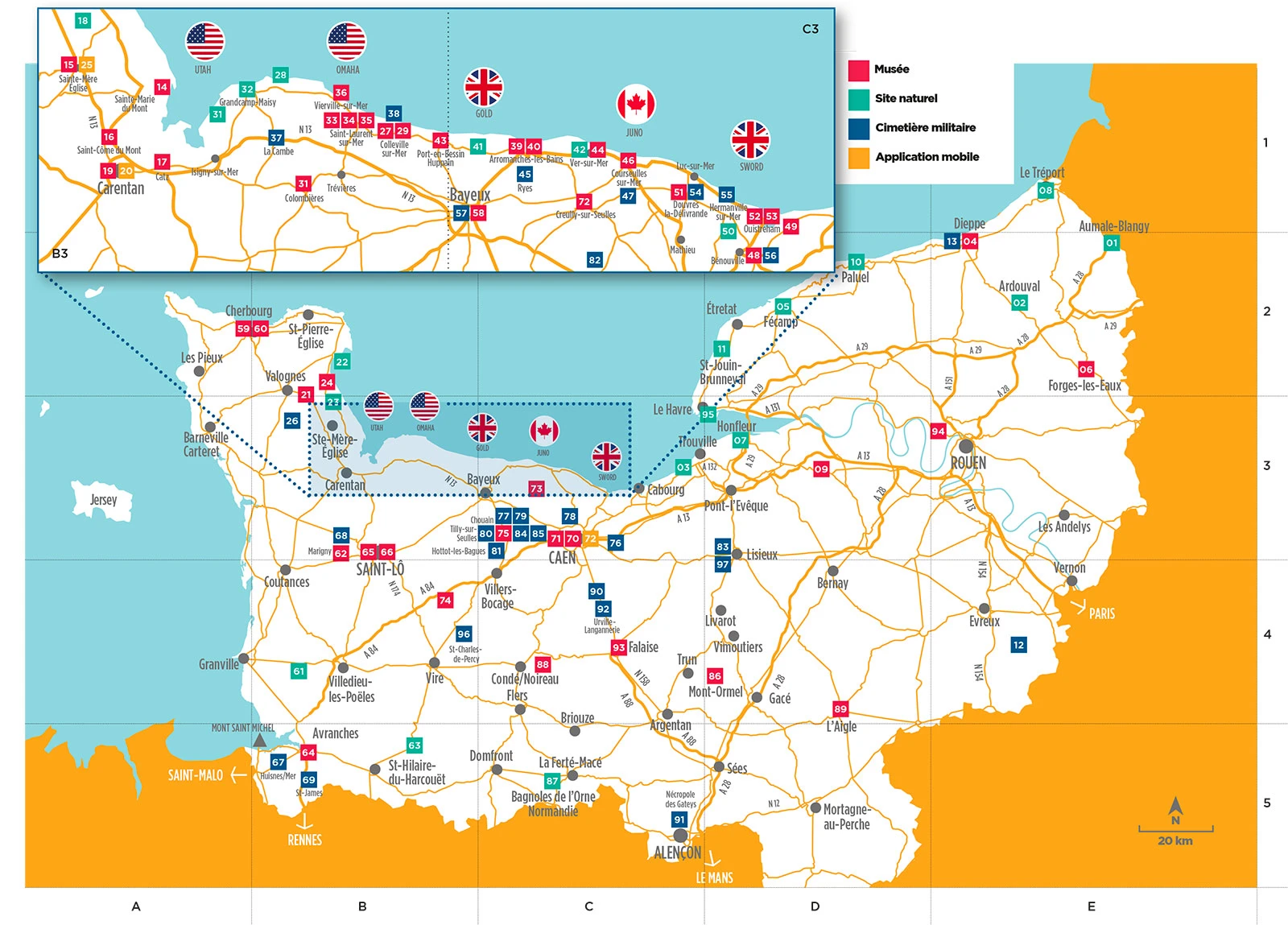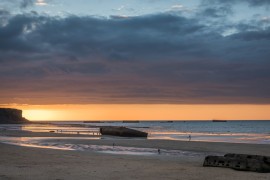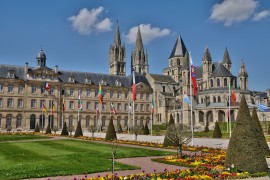Operation Overlord: landing in Normandy
The landing on Omaha beach photographed by an American soldier. Photo chosen by monsieurdefrance. American public domain via WikiCommons.
Breaking through the Atlantic wall
The idea behind the Normandy landings, codenamed "Operation Neptune", was to break through the Atlantic Wall and enter Nazi-occupied Europe. This was the start of a much larger operation: Operation Overlord, which aimed to penetrate occupied France and liberate it from the yoke of the Nazis, before moving on to Germany. The equivalent operation had already been successfully launched in Italy in September 1943, and the Allied armies were advancing through the Italian peninsula. Several locations were considered : the Netherlands, to reach Germany more quickly, and France. Brittany, northern France, or Normandy, in the Cotentin or Calvados regions. In the end, Normandy proved to be the ideal place to break through and hold on to the European continent, providing the bridgehead needed to launch over 1,000,000 men into the reconquest of Liberty .
A German soldier on the Atlantic Wall in Gironde. Photo chosen by monsieurdefrance.com: By Bundesarchiv, Bild 101I-263-1580-13 / Wette / CC-BY-SA 3.0, CC BY-SA 3.0 de, https://commons.wikimedia.org/w/index.php?curid=5410588
Intense preparation
In the months leading up to D-Day, Great Britain increased the number of troops on its soil. American soldiers were increasingly numerous. More and more military equipment. So many air bases were set up on British soil that it was customary to joke that a plane could literally taxi all over Britain without ever taking off, as it flew from one air base to the next. Soldiers are trained on beaches similar to those they will assault in Normandy. These beaches were designated after men in diving suits had scouted French beaches in small submarines to measure their declinivity and take sand samples... We know almost everything about these beaches. They are also studied in the French books about them that are in English libraries. This is how we discovered that certain beaches can be terrible for chariots, because the water and sand mixed together can form a kind of quicksand. So we adapted our tanks to these conditions. Thanks to the French Resistance, we were able to reconstitute all or part of the German installations on the Atlantic Wall that were about to be attacked. The soldiers are training hard. There was even a dress rehearsal for the planned assaults on Omaha and Utah with Operation TIGER. The operation turned out to be a fiasco.
Utah Beach. One of the Normandy landing beaches. Photo chosen by monsieurdefrance.com: Depositphotos
Bigots and Operation Tiger
It's all the more catastrophic because we thought we'd lost some "bigots". Bigots are members of the army who are among the very few who know where the Normandy landings will take place. Bigot is their code name. They work in places where no one ever goes inside (not even to clean, which is not without its annoyances...). On April 27, 1944 , during Operation Tiger , 10 "bigots" were killed off an English beach. They were carrying crucial information, including the planned date and place of D-Day. All means were deployed to ascertain their deaths, and above all to recover the bodies and the information the victims had on them. Nine were found the same day. It would take several days to find the 10th body, finally washed out to sea. Had it not been found, we might have had to start all over again, in the doubt that the Germans might have found the body and the landing maps it was carrying.
American soldiers during Operation Tiger training. Photo chosen by monsieurdefrance.Com: By U.S. Signal Corps, Public domain, https://commons.wikimedia.org/w/index.php?curid=24413761
Operation Mulberry and the artificial port of Arromanches
The aim of D-Day was to break through the Atlantic wall so that men and weapons could be landed easily and regularly. And for that, you need a port. This was one of the reasons for the failure of the Dieppe raid in 1942: no port was available. Cherbourg was considered for a while, but it was one of the fortresses decreed by Hitler himself. These fortresses are over-armed, and orders are given never to surrender, even if it means committing suicide on the spot. Cherbourg is impregnable. The same goes for the Breton ports (Saint Malo, for example), and the ports on the Normandy coast are not large enough to accommodate thousands of ships and men. One officer quipped that a port would have to be built just before landing. Far from being taken in jest, his idea was explored. So it was decided to launch Operation Mulberry , which consisted in building a harbour in parts, to be installed once the beaches had been stormed. The harbour is made up of reinforced concrete caissons, poured in a specific order and linked by gangways that rise and fall with the tides. A pipeline from Great Britain will reach the artificial port to deliver the fuel needed by the thousands of vehicles (tanks, trucks...). Stored for a long time in the port of London in the greatest secrecy, the caissons followed the armada on the morning of June 6 and were installed . Thus was born the artificial port of Arromanches, whose visible remains still speak of the enormous size of the port created by the Allies in June 1944.
They would lead the Normandy landings Front row: Air Chief Marshal Arthur Tedder; General Dwight D. Eisenhower; General Bernard Montgomery. Back row: Lieutenant-General Omar Bradley; Admiral Bertram Ramsay; Air Chief Marshal Trafford Leigh-Mallory; Lieutenant-General Walter Bedell Smith. Photo selected by monsieurdefrance.com domain public via WikiCommons.
In June 1944, everyone was ready, even if hardly anyone knew where the D-Day landings would take place. Nobody, least of all the Nazis, who were lost in conjecture as to where and when it would all happen. If they find out, they can hope to concentrate their forces there and repel the sea assault. Such is the importance of secrecy...
Espionage to make D-Day a success
A beach in Normandy. Photo chosen by monsieurdefrance.com: ChiccoDodiFC via depositphotos.
Total secrecy
The Nazis, too, believed that the Allies wanted to land. For a long time, they hesitated between northern France and Normandy as a possible landing site. Aware of this, the Allies, led by the British, did everything in their power to persuade the Germans that the D-Day landings would take place in Northern France. The bombardments, for example, were twice as heavy as in Normandy, so that the Nazi military, counting the bombs, considered that, if there were so many in the North, that's where the D-Day landings would take place. The Allies ensured that the Germans believed that the landings would take place in places other than Normandy, and with total secrecy, measures were taken to prevent leaks. For example, a young man who had boasted to his parents that he knew where the D-Day landings would take place was arrested and imprisoned during the operations. Having succeeded in cracking the ENIGMA code that enabled the Nazis to communicate by radio, the Allies were able to see that, on the face of it, the Nazis suspected nothing.
Beach names
To prevent anyone from identifying the places imagined for D-Day, the French names of the beaches were erased in favor of code names. For example, during a business meeting, American General Omar Bradley asked two of his officers from the state of Nebraska to tell him which towns they were from. Utah for one. Omaha for the other. 2 Nebraska town names assigned to two beaches. A little later, the British propose their code names, always a little original, very simple and even a little amusing. For one, there's Goldfish, which means "goldfish", and which is shortened to Gold over time. The same goes for Swordfish, which means "swordfish" and will be shortened to Sword. Finally, for the 5th beach, the English propose "Jellyfish" for "jellyfish", shortened to Jelly, which sounds like "Gelly" meaning... Jam. Enough is enough. Churchill asked for a name change. A Canadian officer solved the problem by proposing to take his wife's original first name: Juno. Accepted. Whew!
These beach names caused a cold sweat in May 1944, when they were the subject of a crossword puzzle in the popular newspaper "The Daily Photograph". The grid contained the words "OVERLORD", "UTAH" and "OMAHA". The game's designer, a teacher, was immediately arrested and interrogated. In the end, he was convinced that the grid was pure chance. In any case, the alert was hot.
A fake General Montgomery
In March 1944, spotted by chance in a cafe, an Australian actor named Clifton James, who bears a striking resemblance to Montgomery, the British army chief, is recruited. He follows the general everywhere, taking in his intonations, his poses... On May 25, 1944, dressed like his model and fitted with dummy fingers (he had lost a finger and had to be fitted with a fake rubber one), the actor was sent to Gibraltar on an inspection tour as Montgomery. The idea was that German spies would see him and consider that if the leader of the British D-Day armies was in southern Spain, he wasn't at the head of his men, so D-Day wasn't in the cards.
Montgomery's Clifton James / source de monsieurdefrance.com : wikipedia / Wikicommons
The real General Bernard Law Montgomery / source de monsieurdefrance.com : wikipedia / Wikicommons
And even a fake rubber army
Thanks to their mastery of radar, the British were able to spot German planes and destroy them, but they deliberately let planes pass over south-east England, where they could see an army from above. Regaining Germany unharmed, the pilots can testify that the largest army is positioned just off the coast leading to northern France. A masterful hoax called "Operation Fortitude", since it's a fake army. Rubber tanks that look good from above. The British left nothing to chance, breaking up the surrounding fields as if the wheels of numerous tanks had passed over them. The American General Patton was appointed leader of this phantom army, and care was taken to ensure that his orders were given by radio so that they could be picked up by the Germans, who eventually imagined that this army was the American landing force and that, given its geographical position, it would be landing in the Pas-de-Calais.
A Sherman tank... Gonglable... Source de Monsieurdefrance.com : Wikipedia / Wikicommons.
The most stressful weather forecast in the history of the world.
Weather forecasts were crucial to the success of the D-Day landings. No one was hoping for glorious weather, especially as the beginning of June 1944 was very rainy in Great Britain and France, but the time had to be found when the weather would be calmer in order to set the date for the start of operations. James Stagg, the Allied army forecaster, was under immense pressure. He proposed June 5, and on that day, the convoy began to set off, only to be stopped dead in its tracks. Only one boat continued, but fortunately it was stopped a little later, before going on to make the landing alone... Forecasts are more reliable for the following day, June 6. The soldiers remain locked in the ships for another 24 hours before leaving.
The weather map of Western Europe on June 5, 1944. Source de Monsieurdefrance.com : wikipedia.
The Germans, too, were scanning the weather, but they didn't have the right information because they didn't have any sounding balloons in the Atlantic that would enable them to distinguish the waning weather disturbances. As far as they were concerned, the weather to come was as rainy and windy as ever, making landing impossible. They were so serene that a meeting of the West German generals was scheduled for Rennes on June 6, and most of the officers were on their way to Brittany. Even Field Marshal Rommel, who had warned that the Allies would land in the rain in the early hours of the morning, returned to Germany to celebrate his wife's birthday.
All nationalities are ready to fight.
The flags of the Allied nations on a Normandy beach. Photo chosen by monsieurdefrance.com: francofox via depositphotos.com
In the Allied armies, we find the main free nations such as the United States of America, the Kingdom of Great Britain and Northern Ireland, as well as the Commonwealth countries of Canada (including Quebecers, back in the land of their ancestors), Australia and New Zealand. There are also soldiers from countries occupied by the Nazis: the Free French Forces (who have just chosen the Cross of Lorraine as their emblem), including the famous Kieffer commando, the forces of thePolish Army of the West, the Free Belgian forces, the Free Czechoslovak forces and the Norwegian forces .
The reverse path of Roger de Montgomery's descendant
Speaking of going back to one's roots, this is also the case for British army chief Bernard Law Montgomery, whose ancestor Roger de Montgomery dashed off in the opposite direction to his descendants, since he was at William the Conqueror's side in the conquest of England at the Battle of Hastings in 1066. His family had long held strongholds in Great Britain and Normandy. The general passed not far from his family's birthplaces of Saint-Germain de Montgommery and Sainte-Foy de Montgommery. Roger de Montgomery ended his life in an English abbey, praying for his salvation.
D-Day
Photo chosen by monsieurdefrance.com: Depositphotos.
The arrival of an immense and incredible convoy
The landing was made possible by thousands of ships: from the largest modern destroyer to the most modest old military ship, as well as hundreds of Higgins barges. In all, 4,266 transport ships and 722 warships set off across the Channel on the evening of June 5, 1944. They were spread over 35 km and carried 156,115 Allied soldiers. Earlier, at 2 a.m., 11,500 aircraft, including 3,000 bombers, left Great Britain to drop paratroopers behind the Atlantic Wall and bomb strategic sites.
The American battleship Nevada in action on the morning of DDAY. Photo chosen by monsieurdefrance.com: By Official U.S. Navy photograph - http://www.history.navy.mil/photos/images/g250000/g252412c.htm, Public domain, https://commons.wikimedia.org/w/index.php?curid=732832
With its share of surprises, both good and bad.
The landing went as smoothly as possible. Although the losses were tragic, they were lower than those imagined by the Allied commanders. However, not everything went according to plan... Utah beach was not the one originally planned, and we arrived 2 km from the designated beach. General Roosevelt (a distant cousin of President Roosevelt) decided to start where he had arrived, rather than try to reach the original location. Likewise, the parachutists didn't fall at the places originally planned . At Sainte Marie du Mont, near Utah beach, many fell into the marsh (and drowned), or were widely scattered, taking a long time to find each other. Near the village, there were even more leaders than soldiers, prompting one officer to say "never have so few men been commanded by so many". At Sainte Mère Eglise, the parachutists landed in the middle of the village, where a fire was raging and, in addition to the villagers who were taking turns to extinguish the flames, the German soldiers were numerous. They fire on the parachutists as they fall from the sky. One of these parachutists lands on the church tower, where his web hangs. The man finds himself suspended in the void. No one sees him, but he sees his comrades being massacred. He remains there for long hours, deafened by the sound of bells sounding the alarm. His story was told in the film "The Longest Day".
Remembrance of the American soldier who hung on the Sainte-Mère-Eglise bell tower during the night of June 5-6, 1944. Photo chosen by monsieurdefrance.com: Packshot via depositphotos.
At Omaha, the bombardment was not well aimed and the German installations were unharmed, so it was necessary to attack by climbing the cliffs to catch the Germans from the rear . As a result, while at Utah Beach in the west, the breakthrough was immediate, this was far from the case at Omaha. There were traffic jams on the beaches due to the massive arrival of barges and their cargo of men and equipment. The Calvados front was still very thin, and it would be weeks before we managed to break through to Caen, which was to have been taken quickly according to plan. The hedges were a nasty surprise for the soldiers. There are a lot of them in this Normandy region, and the centuries-old trees with their powerful roots act as natural bulwarks for the German soldiers. They are also impossible for tanks to penetrate.
Hobo's menagerie
General Percy Hobart (1885-1957) Photo chosen by monsieurdefrance.com: By Tanner (Lt), War Office official photographerPost-Work: User:W.wolny - This photograph H 20697 comes from the collections of the Imperial War Museums (collection no. 4700-37), Domaine public, https://commons.wikimedia.org/w/index.php?curid=444902
It was the genius of Percy Hobart that changed everything. This British engineer, brother-in-law of General Montgommery, is an impressive inventor. Every problem encountered by tanks made him think and find the solution to solve the problem. For example, he invented the "fascine" tank, which carries bundles of wood to fill ditches. The "Fléaux" tank turns chains in front of it to detonate mines buried on beaches, while the crocodile tank is equipped with a flame thrower instead of the traditional machine gun. The rhinoceros tank is designed to pierce hedges rather than climb them. Iron bars are attached to the tank to break through the embankments.
The Bobine tank, designed by Percy Hobart, rolls out a kind of large carpet that allows other tanks to roll over the shifting sands of Normandy beaches at low tide. Photo chosen by monsieurdefrance.com: By Laing (Sgt), War Office official photographerPost-Work: User:W.wolny - This photograph H 37411 comes from the collections of the Imperial War Museums (collection no. 4700-37), Domaine public, https://commons.wikimedia.org/w/index.php?curid=440646
Resistance in action
Via BBC "personal messages", French resistance networks were warned to prepare for the arrival of the Allies. They sprang into action. Telephone networks, railways... were destroyed. Many resistance fighters were taken prisoner and killed.
In Normandy: the martyrdom of cities
At the time of D-Day, bombing raids were taking place in Normandy. Railway stations were targeted to prevent German divisions from moving up the English Channel. Many towns were hit by bombing before and after June 6. Many were destroyed in the "Battle of Normandy", which had just begun. Caen, Argentan, Falaise, Saint Lô, Cherbourg, Flers... were all devastated. With more than 10,000 dead between June and August 1944, and all this destruction, Normandy paid a very heavy price for Freedom. It will never forget. Nor those who risked their lives to put an end to the Nazi night.
Caen, ravaged by bombing. Photo chosen by monsieurdefrance.com: By US Army - Conseil Régional de Basse-Normandie / National Archives USA, Public domain, https://commons.wikimedia.org/w/index.php?curid=7472260
The beginning of the Battle of Normandy
German soldier prisoners. They are extremely young. Some are as young as 15. The Reich no longer has enough men to hold out on two fronts, West and East. Photo chosen by monsieurdefrance.com: By Author unknown - Own work, CC BY-SA 4.0, https://commons.wikimedia.org/w/index.php?curid=129289136
Overlord will succeed.
The Landing was the very beginning of a much larger operation that went down in history as the "Battle of Normandy". Nearly 3,000,000 Allied soldiers took part in the battle before setting off to liberate Paris. The battle lasted several months, beginning on June 6 and ending on August 29, 1944. The Allies succeeded in breaking through to Avranches, south of the Cotentin peninsula, and on to Brittany. Cut off from German troops, the fortress of Cherbourg fell. After launching some of their troops to liberate Brittany, the Allies faced a German counter-offensive. After putting an end to this counter-offensive, the Allies circumnavigated Normandy to the south, before climbing back up. At this point, other Allied troops succeeded in breaking through to Caen. The two sides met again near Falaise, closing what came to be known as the "Falaise pocket" and literally pounding the defeated German troops. Liberated in the rear, the Allied armies were able to move towards Paris, which was liberated by the only French division: the 2nd D.B. To the south, the Provence Landings liberated the south of the country. In the Vosges and Belgium, the Allies attacked Germany (which had collapsed in the east in the face of the Soviet army).
Des chars allemands détruits dans la Poche de Falaise par les soldats polonais. Photo choisie par monsieurdefrance.com : Par Auteur inconnu — Press services of 1st Polish Armoured Division,press released by Polish Government Ministry of Information Photo Service in 1944.Franciszek Skibiński Falaise, Warszawa 1984, ISBN 83-05-11205-5.Tadeusz Antoni Wysocki 1 Polska Dywizja Pancerna 1939-1947 : geneza i dzieje 2nd edition. Warszawa 1994, ISBN 8311082197, Domaine public, https://commons.wikimedia.org/w/index.php?curid=1065401
Remembrance today
The map, very well done by Normandie Tourisme, showing the sites to see in connection with the Battle of Normandy. Screenshot Normandie Tourisme.
Normandy, of course, has never forgotten the historic event of global proportions that took place on its soil. Its towns and cities bear the memory of this event in stone, as almost all of them were rebuilt, at least in part, after the war. Many cemeteries, American, British, German... are to be found in Normandy, and are the object of much care and attention. Last but not least, there are many cultural sites where you can continue to learn about this history. Click here to discover the 5 DDAY beaches.
To mark the 80th anniversary of the Normandy landings, a number of events have been organized. Normandie Tourisme has set up a well-designed website and map showing everything you can see and discover in Normandy in connection with the D-Day landings. You'll find all the info here .
FAQ
How many Allied soldiers landed in Normandy?
Approximately 156,000 men on June 6, 1944.
Which beach was the deadliest?
Omaha Beach, with extremely heavy American losses.
What was the impact of the Normandy landings?
They enabled a second front to be opened in Europe, hastening the defeat of Nazi Germany.

